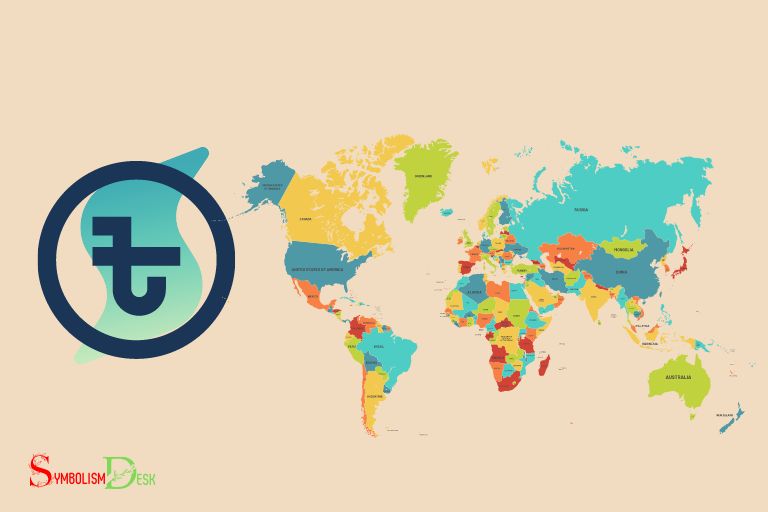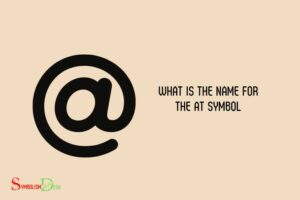Currency Symbols With Country Name: Find Out Here!
Currency symbols are graphic symbols used to represent various monetary units across different countries. These symbols are unique to each country and aid in distinguishing their currencies from one another.
Currency symbols typically comprise one or two letters or a unique character that represents a country’s currency.
When dealing with international transactions, it is essential to identify the specific currency being used, as exchange rates fluctuate and different currencies have varying values.
This is where currency symbols come into play, providing a straightforward method of identifying a country’s currency.
Currency symbols are crucial in today’s global economy, as they provide a clear and easily recognizable way of identifying different currencies.
For example, the United States uses the dollar symbol ($), while the United Kingdom uses the pound symbol (£).
Additionally, the euro, which is used by many European Union countries, is represented by the symbol (€).
By using these unique identifiers, businesses and individuals can easily navigate international transactions and avoid potential confusion or financial errors.
16 Country Name with Currency Symbol
| Country Name | Currency Symbol |
|---|---|
| United States | $ |
| European Union | € |
| United Kingdom | £ |
| Japan | ¥ |
| Canada | CAD $ |
| Australia | AUD $ |
| China | ¥ |
| India | ₹ |
| South Korea | ₩ |
| Brazil | R$ |
| Russia | ₽ |
| South Africa | R |
| Turkey | ₺ |
| Mexico | MXN $ |
| Switzerland | CHF |
| New Zealand | NZD $ |
Key Takeaway

Five Facts About Currency Symbols With Country Name
Understanding The Importance Of Currency Symbols In International Trade
Currency symbols with country name: understanding the importance of currency symbols in international trade
Global trade has come a long way, from bartering goods and commodities to conducting business across borders with ease. It has become a fundamental part of our lives, and currency symbols have made it possible.
Brief History Of Currency Symbols And Their Gradual Adoption Worldwide
The usage of currency symbols was primarily initiated in the seventh century during the minting of coins in lydia, a tiny kingdom in ancient turkey.
Over time, different cultures and countries have developed their currency symbols that are easy to decipher.
Here’s a brief overview of the evolution of currency symbols:
- The us dollar ($) sign originated from the spanish currency ‘pesos’ that bore the ‘ps’ symbol.
- The euro (€) was launched in 1999 and represents the collective currency of the european union.
- Japanese yen (¥) displays the same character as the chinese yuan (元) and is derived from the chinese characters of ‘circle’ and ‘unit.’
- The british pound sterling (£) is probably one of the oldest currency symbols in use, dating back to the eighth century.
How Symbols Have Simplified Global Trade And Eliminated Confusion And Ambivalence
Currency symbols have simplified global trade by eliminating the possibility of confusion and misunderstanding that were rampant before the adoption of these symbols.
Here are some of the advantages of using currency symbols in international trade:
- Currency symbols serve as a visual representation of the respective currency and ease the identification and conversion of currencies across the world.
- Symbols have reduced ambiguity and confusion in transactions, preventing the possibility of mistakes and mistransactions.
- The use of currency symbols enables traders to transact faster and with greater accuracy, resulting in improved productivity and profitability.
- In industries, such as travel and tourism and e-commerce, currency symbols are essential to make transactions smoother and hassle-free.
The widespread adoption of currency symbols has made conducting international trade effortless, resulting in a boon for businesses worldwide.
Top 10 Currency Symbols And Their Country Name (With Images)
Us Dollar – United States
The us dollar, abbreviated as ‘usd’, is the most commonly traded currency globally and is issued by the federal reserve.
It has the following sub-units: 1 cent or $0. 01; 1 dime or $0. 10; 1 quarter or $0. 25; 1 half-dollar or $0.
50 and a 1 dollar coin. Here are some facts about the us dollar:
- The symbol of us dollar is $ and is derived from the spanish dollar.
- The us dollar is used as the official currency in the united states of america.
- Us dollar is the most powerful currency in the world and is used as a benchmark in trading and finance.
- In the world of forex trading, the us dollar is predominantly used as a counter currency.
- The us dollar is also the most counterfeited currency, with $20 and $100 bills being the most forged.
Euro – European Union
The euro is the second most traded currency globally and is issued by the european central bank.
It has the following sub-units: 1 cent, 2 cents, 5 cents, 10 cents, 20 cents, 50 cents, 1 euro, and 2 euros.
Here are some facts about the euro:
- The euro is used as the official currency across the 19 countries of the european union.
- The euro symbol is € and represents the first letter of the word “europe.”
- The euro was launched in 1999 and became the currency of the eurozone in 2002.
- The euro is the second most traded currency in the world, and it is used in international finance and investment.
- Germany, france, spain, and italy are among the major economies that use the euro.
Japanese Yen – Japan
The japanese yen, abbreviated as jpy, is used as the official currency of japan and is issued by the bank of japan.
It has the following sub-units: 1 yen, 5 yen, 10 yen, 50 yen, 100 yen, and 500 yen.
Here are some facts about the japanese yen:
- The japanese yen is the third most traded currency in the world, and it is mainly used in the asian continent.
- The symbol of japanese yen is ¥, and it is pronounced as “yen.”
- Japan is an export-driven economy, and the japanese yen is sensitive to international trade.
- Japanese yen is used in carry trades, which means investors borrow in low-yielding currencies like yen to invest in high-yielding currencies.
- The japanese yen is a safe-haven currency and tends to appreciate during economic uncertainties.
British Pound Sterling – United Kingdom
The british pound sterling, abbreviated as gbp, is used as the official currency of the united kingdom and is issued by the bank of england.
It has the following sub-units: 1 penny, 2 pence, 5 pence, 10 pence, 20 pence, 50 pence, £1, and £2.
Here are some facts about british pound sterling:
- The symbol of the british pound sterling is £, which is derived from the latin word ‘libra.’
- The british pound sterling is the fourth most traded currency in the world and is also known as the cable.
- The british pound sterling is the oldest currency in the world still in use.
- The british pound sterling is used as a reserve currency by many central banks worldwide.
- The brexit referendum in 2016 resulted in a sharp drop in the value of the british pound sterling.
Swiss Franc – Switzerland
The swiss franc, abbreviated as chf, is used as the official currency of switzerland and liechtenstein and is issued by the swiss national bank.
It has the following sub-units: 5 centimes, 10 centimes, 20 centimes, 50 centimes, 1 franc, 2 francs and 5 francs.
Here are some facts about the swiss franc:
- The swiss franc is a safe-haven currency and is used as a reserve currency by many central banks worldwide.
- The symbol of the swiss franc is chf, which stands for ‘confoederatio helvetica franc.’
- Switzerland is a neutral country, and the swiss franc is not affected by international economic events.
- The swiss franc is the only currency in the world to have negative interest rates.
- Swiss franc is the sixth most traded currency in the world.
Canadian Dollar – Canada
The canadian dollar, abbreviated as cad, is used as the official currency of canada and is issued by the bank of canada.
It has the following sub-units: 1 cent, 5 cents, 10 cents, 25 cents, 50 cents, $1, and $2.
Here are some facts about the canadian dollar:
- The symbol of the canadian dollar is c$, which is also referred to as the loonie.
- Canada is a resource-rich economy, and the canadian dollar is sensitive to commodity prices.
- The canadian dollar is the seventh most traded currency in the world.
- The canadian dollar is used in trading with the united states, and the exchange rate between cad and usd is significant.
- Canadian dollar is a floating currency and is not pegged to any other currency or commodity.
Indian Rupee – India
The indian rupee, abbreviated as inr, is used as the official currency of india and is issued by the reserve bank of india.
It has the following sub-units: 50 paise, 1 rupee, 2 rupees, 5 rupees, 10 rupees, 20 rupees, 50 rupees, 100 rupees, 200 rupees, 500 rupees, and 2000 rupees.
Here are some facts about the indian rupee:
- The indian rupee is the official currency of india, bhutan, and nepal
- The symbol of the indian rupee is ₹, and it was launched in 2010.
- The indian rupee is a highly regulated currency, and its exchange rate is determined by the reserve bank of india.
- The indian rupee is a high yield currency and is sensitive to domestic events like inflation and interest rates.
- Indian rupee is the 20th most traded currency in the world.
Australian Dollar – Australia
The australian dollar, abbreviated as aud, is used as the official currency of australia, christmas island, cocos islands, heard island, and mcdonald islands, kiribati, nauru, norfolk island and tuvalu.
It is issued by the reserve bank of australia. It has the following sub-units: 1 cent, 2 cents, 5 cents, 10 cents, 20 cents, 50 cents, $1 and $2.
Here are some facts about the australian dollar:
- The symbol of the australian dollar is $, and it is nicknamed the aussie.
- Australia is a resource-rich country, and the australian dollar is sensitive to commodity prices.
- The australian dollar is a floating currency and is not pegged to any other currency or commodity.
- The australian dollar is the 5th most traded currency in the world.
- The australian dollar exchange rate is significant with the us dollar.
Singapore Dollar – Singapore
The singapore dollar, abbreviated as sgd, is used as the official currency of singapore and is issued by the monetary authority of singapore.
It has the following sub-units: 1 cent, 5 cents, 10 cents, 20 cents, 50 cents, and $1, and $5, $10, $50 and $100.
Here are some facts about the singapore dollar:
- The symbol of the singapore dollar is $ or s$, and it is commonly referred to as the sing.
- Singapore is a small open economy, and the singapore dollar is keenly sensitive to global economic events and trade flows.
- The singapore dollar is the 14th most traded currency in the world.
- The singapore dollar is a floating currency and is not pegged to any currency or commodity.
- The singapore dollar is a high yield currency and is sensitive to domestic events like inflation and interest rates.
Chinese Yuan – China
The chinese yuan, abbreviated as cny, is used as the official currency of china and is issued by the people’s bank of china.
It has the following sub-units: 1 jiao, 2 jiao, 5 jiao, 1 yuan, 2 yuan, 5 yuan, 10 yuan, 20 yuan, 50 yuan, and 100 yuan.
Here are some facts about the chinese yuan:
- The symbol of the chinese yuan is ¥, and it is also known as renminbi.
- China is the world’s second-largest economy, and the chinese yuan is keenly sensitive to global economic events and trade flows.
- The chinese yuan exchange rate is controlled by the chinese government, and its value is not fully determined by market forces.
- The chinese yuan is the 8th most traded currency in the world.
- The chinese yuan is used in international trade and investment in china.
United States Dollar
Historical Significance Of The Us Dollar
The united states dollar symbol is the most recognized and dominant currency symbol globally. The us economy has been an influential force in the world economy, and the us dollar has played a significant role in that.
It is imperative to understand the historical significance of the us dollar to appreciate its dominance fully.
- The us dollar replaced the spanish dollar as the world’s most prominent currency during the 20th century.
- The globally accepted gold standard, which was in place until 1971, saw the us dollar pegged to gold, establishing the us as the strongest economy globally.
- The us dollar has been used in international trade commonly, with countries pegging their currencies to the us dollar or using it as a reserve currency.
Explanation Of The Dollar Symbol And How It Came Into Existence
The us dollar symbol, “$,” has been in use since the late 1700s. It is widely used to represent the us currency and recognized in countries where the us dollar is used as a medium of exchange.
- The symbol’s origin is from the spanish dollar, which had a similar symbol. Replicating the symbol made it easy to identify the dollar.
- Some believe that the “$” symbol is a combination of the letters ‘u’ and ‘s,’ making it the united states dollar symbol.
Brief Overview Of The Us Economy
The united states is the world’s largest economy, and the us dollar plays a vital role in facilitating international trade. The economy’s robustness can be attributed to a variety of factors.
- The us economy is characterized by various industrial sectors, including agriculture, manufacturing, and services.
- The us has a well-developed infrastructure, which has contributed to its economy’s growth.
- The country’s high level of education has resulted in a highly skilled workforce, who innovate and lead to new market developments.
Understanding the united states dollar’s historical significance, the dollar symbol’s origin, and the country’s economy is critical in appreciating the dollar’s dominance globally.
Euro
Brief History And Introduction Of Euro
The euro has become one of the most popular currencies in the world. Created in 1999, it wasn’t until a few years later that the euro was introduced to the public.
The euro replaced various currencies in 19 european union (eu) countries, including the deutschmark, french franc, and italian lira.
Explanation Of The Euro Symbol And Its Origin
The euro symbol, €, was designed by a belgian named alain billiet in 1996. The shape of the symbol comes from the letter e, which represents europe. The two horizontal lines in the symbol represent stability, while the lighter color represents hope.
The euro symbol has become iconic and is now used around the world.
Overview Of European Union Economy
The eu is one of the largest economies in the world, with a gross domestic product (gdp) of almost €15 trillion.
Here are some key points about the eu economy:
- The eu is made up of 27 member countries with a total population of over 440 million people.
- The eu is the largest exporter of goods and services in the world.
- Germany, france, and italy are the largest economies in the eu.
- The euro is the second most traded currency globally, behind only the us dollar.
The euro has become an essential currency over time, with the euro symbol being a recognizable part of our everyday lives, used in all sorts of areas from business to tourism.
The eu economy is one of the biggest in the world, with many member countries contributing to its impressive economic growth.
Japanese Yen
Historical Significance Of The Yen
The yen is the official currency of japan and has a rich history dating back to the meiji period (1868-1912).
Here are some key historical points to remember:
- The yen was introduced as a replacement to tokugawa coinage in 1871 when japan moved from a feudal system to modernize its economy and monetary system.
- The yen was originally pegged to the gold standard in 1897
- During world war ii, japan’s currency was destabilized, and in 1949 a new yen was introduced worth 1/100th of the pre-war yen
- Since then, the yen has played a crucial role in the japanese economy and is now one of the world’s most traded currencies.
Explanation Of The Yen Symbol And How It Was Formed
The yen symbol, ¥, represents the japanese currency in both japanese and western languages. The symbol is derived from the chinese character “圓,” meaning round or circular, which was used in ancient chinese coins.
Here are some key points about the yen symbol:
- The yen symbol is commonly referred to as “yen” but is sometimes called “en” in japan.
- The yen symbol was officially adopted in 1887, replacing the previous yen sign, which resembled the chinese character “元”.
- The symbol’s popularity in western countries grew after world war ii and is now recognized globally.
Overview Of Japanese Economy And Its Relation To The Yen
The japanese economy is the third largest in the world by nominal gdp and the fourth largest by purchasing power parity.
Here are some key points about the japanese economy and its relation to the yen:
- The export industry plays a crucial role in the japanese economy, making up a significant portion of the country’s gdp.
- The bank of japan (boj) actively manages the value of the yen to keep the economy competitive.
- The yen is considered a safe-haven currency, meaning it tends to appreciate during times of market uncertainty or stress.
- Japan’s aging population and low birth rate are significant economic challenges, which the government is trying to combat through policies such as monetary easing and fiscal stimulus.
British Pound Sterling
The british pound sterling is one of the world’s most important and oldest currencies. Known as the pound, it was first introduced in the 8th century and has played a significant role in the uk’s economy ever since.
Below we’ll explore the historical significance of the pound sterling, the explanation of the pound symbol and how it was formed, and an overview of the uk economy and its relation to the sterling.
Historical Significance Of The Pound Sterling
- The pound sterling was first introduced in the year 775 ad.
- It’s one of the oldest currencies in the world still in use today.
- The currency played a significant role in the international economy during the victorian era and beyond.
- The pound sterling was also the standard currency for international transactions before the us dollar took over in the 1940s.
Explanation Of The Pound Symbol And How It Was Formed
- The pound symbol is an ornate ‘l’ with a crossbar through the middle, which harks back to the currency’s latin name, libra.
- This symbol was first used to represent the pound in the 14th century.
- In 1694, the bank of england was formed and became the custodian of the pound sterling, which led to the addition of the symbol ‘£.’
Overview Of The Uk Economy And Its Relation To The Sterling
- The uk has the sixth-largest economy in the world, according to gdp.
- The economy has a strong service sector, responsible for nearly 80% of gdp.
- The uk is also a major exporter of goods and services, with exports accounting for around 31% of gdp.
- The pound sterling is a floating currency, which means its value is not fixed against any other currency and is influenced by a range of factors such as inflation, interest rates, and economic growth.
The significance of the pound sterling is seen not only in its age but also in its ability to withstand changing economic climates.
As the uk continues to evolve, so will the pound sterling, ensuring that it remains an important currency in the global economy.
Swiss Franc
Switzerland is known for its natural beauty, chocolates, and of course, its currency, the swiss franc (chf).
The swiss franc is used in both switzerland and liechtenstein and is known for its stability and value.
Historical Significance Of The Swiss Franc
The swiss franc has a rich and fascinating history. Here are some key points:
- The swiss franc was first minted in 1850, replacing the swiss frank.
- The currency was originally based on the swiss 20-franc gold coin, which had been in circulation since the early 1800s.
- In 1865, switzerland joined the latin monetary union, which brought the swiss franc into line with other european currencies, such as the french franc and the italian lira.
- During world war i, the swiss franc gained a reputation as a safe haven currency due to switzerland’s neutrality.
- In 1936, switzerland established a central bank, the swiss national bank (snb), which continues to regulate the currency today.
Explanation Of The Franc Symbol And How It Was Formed
The franc symbol is instantly recognizable as chf, but have you ever wondered how it was formed?
Here are some key points:
- The letters chf stand for confoederatio helvetica franc, which translates to the swiss confederation franc.
- The symbol for the swiss franc is ‘fr.’ Or ‘chf.’ The abbreviation chf comes from the latin term confoederatio helvetica, which means ‘swiss confederation.’
- The franc symbol was first used in the early 1800s on swiss 20-franc gold coins.
Overview Of Swiss Economy And How The Franc Has Influenced It
The swiss economy is known for its stability and its high quality of life. Here are some key points:
- The swiss economy is highly diversified, with strong sectors including finance, pharmaceuticals, and tourism.
- The swiss franc plays a significant role in the swiss economy, serving as a store of value and a means of exchange.
- Due to its stability, the swiss franc is often used as a reserve currency by other countries.
- In 2015, the snb abandoned its policy of pegging the swiss franc to the euro, which caused the swiss franc to appreciate significantly in value. This had a negative impact on swiss exporters, as it made their goods more expensive on the international market.
Overall, the swiss franc is a fascinating and important currency, with a rich history and a significant impact on the swiss economy.
As a stable and valuable currency, the swiss franc is likely to continue to play an important role in the global financial system.
The Impact Of Currency Symbols On International Trade
Currency symbols are visual representations of a country’s official currency, and every country has its unique currency symbol. These symbols are essential because they play a significant role in facilitating international trade.
The Role Of Symbols In Simplifying Trade Exchanges
Currency symbols help simplify international trade exchanges by providing a universal language for buyers and sellers worldwide, regardless of their native tongues.
They aid in the seamless transfer of money from one currency to another, making it easier for countries to trade goods and services.
Here are some key points:
- Currency symbols eliminate the need for translation and reduce the risk of misunderstanding in international trade.
- They offer a straightforward and efficient way of recording transaction data.
- They allow traders to compare the prices of goods and services in different currencies.
How They Have Influenced Stock Markets And Investments
Currency symbols have played a crucial role in the development and growth of stock markets worldwide. They have simplified the transactions of stocks and other securities across borders, providing investors with easier access to new markets.
Here are some key points:
- The use of currency symbols in the global market has led to the increase in trading volumes.
- They encourage cross-listing of companies and shares, making it easier for investors to access foreign markets.
- Currency symbols have led to the growth of exchange-traded funds (etfs), which provide investors with diversified exposure to various markets.
The Importance Of Accurately Representing Currency Symbols In International Transactions
Accurately representing currency symbols is critical in international trade as it ensures that all parties involved in the transaction understand the currency and its value. A single mistake in currency representation can lead to losses, misunderstandings and disputes.
Here are some key points:
- Misrepresenting currency symbols can lead to financial losses and tarnish business relationships.
- It is essential to use the correct currency symbol to avoid confusion in financial reporting.
- Accurately representing currency symbols is necessary in international trade negotiations to prevent misunderstandings and ensure successful transactions.
Currency symbols are a crucial aspect of international trade, investments and financial reporting. Accurately representing them is necessary to ensure successful transactions, avoid misunderstandings, and maintain business relationships.
By simplifying trade exchanges and providing universal language, currency symbols contribute to the growth of the global economy.
Do Women’s Names Also Have Symbolic Meanings?
Yes, every woman’s name symbol signification holds hidden cultural and historical significance. From ancient goddesses to modern icons, names like Athena, Cleopatra, and Marilyn have rich symbolic meanings. Each name can reflect a woman’s heritage, personality traits, or even aspirations. Exploring these symbolisms adds depth and wonder to the stories of remarkable women throughout history.
FAQ For Currency Symbols With Country Name
What Is A Currency Symbol?
A currency symbol is a character or sign representing a specific type of currency.
Why Do Currencies Have Symbols?
Currency symbols are used to identify and distinguish one type of currency from another.
Which Country Uses The $ Symbol For Currency?
Several countries including the united states, canada, and australia use the $ symbol for their currency.
What Symbol Is Used For The Euro Currency?
The symbol used for the euro currency is €.
How Do I Type Currency Symbols?
Currency symbols can be typed on a keyboard using shortcut keys or accessed from the character map on a computer.
Conclusion
Understanding currency symbols is crucial while traveling or doing any form of international business.
It saves us from trading currency at an expensive rate, avoid getting ripped off at the foreign exchange, and helps us in our transactions with different countries.
In this post, we have covered the most used currency symbols with their corresponding name of the countries. After learning about the most used currency symbols, it’s also important to understand the namaste symbol explanation, which represents a respectful greeting in many South Asian cultures. The namaste symbol, with its hands pressed together at the heart, is a sign of reverence and is often accompanied by a slight bow. It is a beautiful and meaningful gesture that conveys a sense of gratitude, respect, and acknowledgment of the divine within each person.
The post is handy for frequent travelers, business persons, and anyone interested in global economics. It provides a quick glance at the respective currency signs and the country names they belong to.
Whether you are traveling to europe or asia, or dealing with clients across continents, this post can be a valuable resource. We hope, you found this blog post insightful and informative, and it will assist you in your future endeavors.






